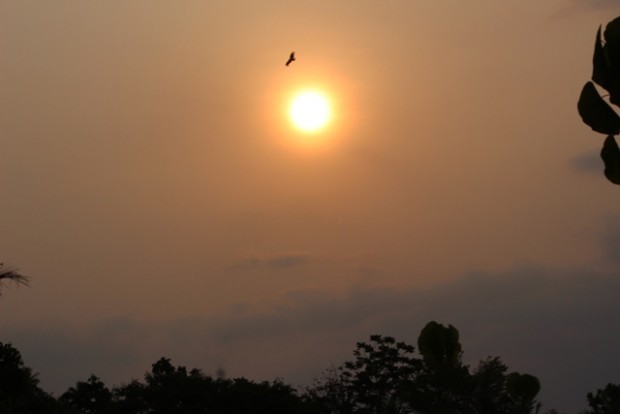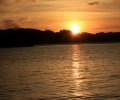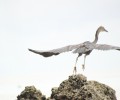Project Update: September 2016
Forest trail
I finished the first loop trail so that we do not have to take the same trail on returning home. It is 5000 meter long, and took me about 200 working days to complete the loop—the daily progress is between 10 m and 50 m, depending on the density of the scrubs or undergrowth.
The loop crosses 13 valleys of various sizes—from 15 m x 50 m to 40 m x 200 m. During the last rainy season, I had to open ring trails around the valleys because all the valley’s floors were covered by deep water; I had to abort some trips with some tourists because the bush was either too dense to clear, or most of it thorny, or too many fire ants in it.
Although not as difficult as creating it, maintaining the trail, especially during heavy rain periods, is not easy either; some slopes are very steep, up to 75 degree. However hard doing both, I enjoy the work. The forest is teeming with birds in the morning; hornbills are everywhere; brahmini kites calling over canopies. In addition, I was lucky seeing cuscuses (a marsupial animal like koala in Ausralia) three times in three trips; in the second one was a mother with a baby on her back—nobody on the island has seen them since we settled down here.
This month is the peak of fruiting season of the strangles figs. On the cathedral fig—its buttresses are oval with axes 5 m x 8 m—macaques have great parties: jumping, crawling, swinging, and screaming. The group consists of around 20 monkeys, with one alpha male is fully alert watching for any danger—he stared down at me while I was taking their photos.
I am opening another trail but this one is a hill trail. It starts from my garden on the peak of the west hill and follows the ridge of the bird valley (the closest valley at the back of our home). So far it is 1500 m long and relatively easy—good for not so fit tourists. I have used it for night trekking to find tarsiers, nocturnal tiny primitive primates.
Garden
I have made the second terrace above the first one using different method. Instead of digging and stepping—which is tough because it is rocky—I shredded the thin topsoil and piled it down linearly so that creating lines of mounds top down the hill. Seeing from the hill top, the garden is another attraction for tourists: forest, huge mango tree, stepping vegetables and fruit garden, coconut trees, sea, and horizon, top down.
Having thought of a better condition of the garden—I had planted it with more than 20 kinds of vegetables and fruit plants three times, but only harvested little chilly—I was optimistic to get a better harvest with the new planting of the same seeds on both the hill and yard gardens after three times of heavy rains. Moreover, I had dug four big holes for collecting rain water at every corner of the second terraced garden and layered them with water-proof canvases.
Two months had passed, only sweet potatoes grew well. The fourth attempt failed again for the following causes: for one month there was no rain two weeks after planting the seeds; many insects bit and ate the leaves of saplings; the crabs (on the flat yard) cut and dragged the stems of the saplings into their holes in the evening; our chicken and roosters scrapped the garden and chopped the leaves of the young plants; the macaques fell our young banana trees and ate our unripe water melon; and the last, the deerpig dug our cassava plants. Never mind, keep trying.
Snails for food
Although our bay is lined with coral reefs, big fish is rare, the result from overfishing and destructive fishing (dynamite and cyanide) by the locals. As the villages are faraway, we rarely buy fish. To have quality protein, we go to the mangroves next bay and collect brackish snails. They are delicious and free, but they take us a long time to crack; one snail gives us a finger tip of meat: one hour for one full hand.
English class
Meidy, my wife, has developed good rapport with the communities by teaching English at the elementary school once a week. Now the students dare have conversation with the tourists who visit the gypsy and Kadoda villages—the adults never address them, by the way.
For extra-curricular activities, Meidy invited some tourists from the resorts and cottages to join beach cleanup with the students. Both groups were very excited in doing it together. They have done this three times within the last six months. The other activity for the students is having picnic, playing game, and doing art works on the platform of the training center in our beach on Sundays.
Current plan
I have written a grant proposal to sustain our project and life on Malenge. If I am lucky with it, the next steps—training dropouts on ecotourism and inviting students from international schools in Bali to stay on Malenge—will be carried out soon.
Requested favor
Please review the draft of my grant proposal attached and forward it to some potential donors (individuals and organizations) you know.





